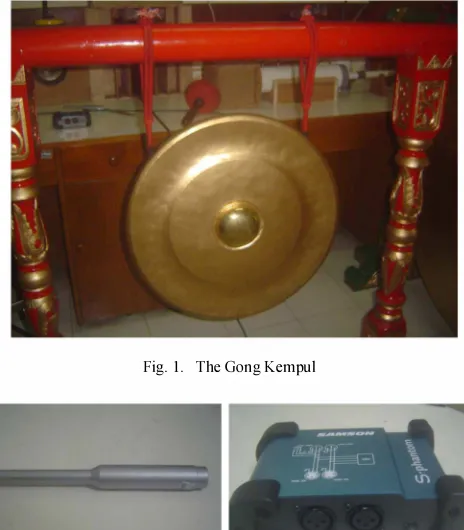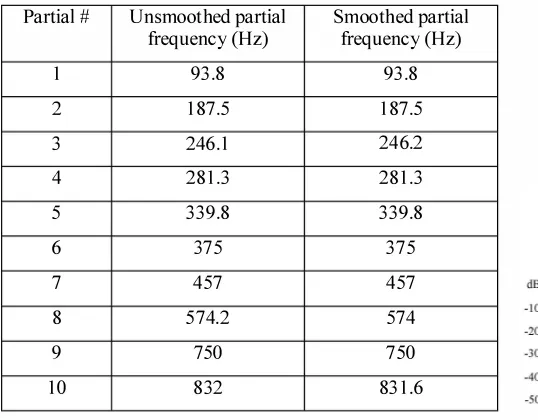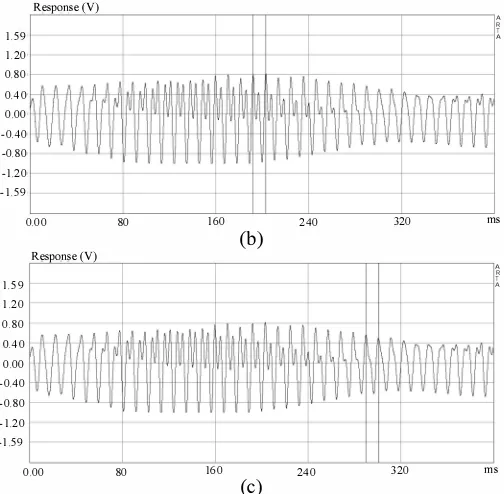The Spectral and Temporal Description of Javanese
Gong Kempul
Matias H.W. Budhiantho1 and Gunawan Dewantoro2
Department of Electronic and Computer Engineering1,ZSatya Wacana Christian University Salatiga, Indonesia [email protected] [email protected]
Abstract- In Central Java, the Gong Kempul is one of eminent gamelan instrument, an ensemble of predominantly struck instruments found across Central Java and has deep philosophical meaning for Javanese. However, there lack of studies concerning on this particular instrument as a bridging means between scientiic description and human artistic perception. This study aims to investigate the spectral and temporal properties as well as particularly look into the typical wave-like sound of the Gong Kempu!. Acoustic measurements were conducted and analyzed using ARTA. Both frequency and time domain analyses were explored to better understand the nature of the Gong Kempu!. It was found that the partials at 93.8 Hz, 187.5 Hz, 281.3 Hz, and 375 Hz are the strict integer between two partials that occur closely.
Kywords-gong kepul; frequency spectrum; beat phenomenon; impulse response; partials
I. INTRODUCTION
Gongs are instruments in Gamelan which perform what is oten termed a colotomic unction in the music to mark off established time intervals [1-2]. The smallest gongs which hang in a crossbar supported by two side posts are the Gong Kempul, as shown in Figure 1 , with 56 cm in diameter. This instrument has a very deep and distinctly pitched roar mimicking the rolling waves of the sea. Sacrilegious aspect of Javanese Gamelan is very obvious, as in [3], and ones need a certain extent of the scientiic countepart. There have been studies in the past that attempt to describe the spectrum of gamelan instruments. Suprapto et al. [4] proposed to consruct gamelan models. The main target of his research was creating Gamelan Frequency Modeling. He proposed two Frequency Balungan Models, the irst model was using average value, and the other was using average value in the most dense area. Tjahyanto et al. [5] proposed a method for the features extraction, selection, and identiication of gamelan note and the proper insrument. [t was an approach based on Fast Fourier Transform (FFT), and support vector machines (SVMs) for note and insrument identiication. Four spectral features were
selected (specral cenroid, two spectral roll-off, and undamental requency) as inputs for SVM. Latief et al. [6] analyzed and identiied Gamelan Bonang sound spectrum. He showed a method for sound-recognition with artiicial neural network back propagation concept. The artiicial neural network used sigmoid activation unction to all layers. Extraction was performed, as well as Fourier transform, allowing the system to do the identiication of voice data Gamelan Bonang using artiicial neural network back propagation concept.
Wulandari et al. [7] investigated the implementation of machine leaning approach to understand statistical variations contained in gamelan signals which are relevant to onsets. The method used Elman Network which consists of one hidden layer. However, there have been lacks of studies in the past that attempt to describe the specrum of gongs both theoretically and experimentally to better comprehend such analyses. Maclachlan [8] employed Finite Element Analysis to predict the effect of a range of variations of gong geometries on modal frequencies. The predicted requencies of the Finite Element Analysis experiment for gong models did not match the acoustic specra for these gongs. However, the results indicate how the near harmonic overtone spectra recorded for these gongs have been produced by the right combination of physical properties. [n his concluding work [9], a series of musical gongs were designed with up to the irst ive overtones tuned to within 5% of the hmonic series using puposeully added presresses generated by cold-forging small dimples. The requencies of overtones were most sensitive to the depth of the dimples located near the maxima of modal sresses.
Ayers and Honer [ 1 0- 1 1] analyzed the Gong Ageng, the largest gong used in Gamelan, using a phase vocoder specral analysis to estimate the amplitudes and requencies of the partials. The Gong Ageng has about a dozen prominent exponentially decaying partials, with some component requency ratios that closely corespond to harmonics and other that are inhmonic. Many of the partials have a slow amplitude and requency modulation of a few Hertz, and a faster modulation around 20 Hz resulting rom multiple components falling into the same harmonic bin. The studies in [ [2-13] indicated that gongs show a pronounced nonlinear behavior. The pitch of the larger gong glides downward as
Fig. 1 . The Gong Kempul
Fig. 2. Condenser microphone (let) and phantom power (right)
much as three semitones ater sriking, whereas that of the smaller gong glides upward by about two semitones. Rossing et al. [ 14] investigated some vibrational modes of the larger gongs. Some of the modes were conined pretty much to the lat inner portion, some to sloping shoulders, and some involve considerable motion in both parts. When the gong was hit near the center, the cenral modes clearly dominate the sound. When the gong was hit lightly on the shoulder, the lowest mode is heard.
This paper considers the specral and temporal properties of Javanese Gong Kempul to examine the spectral harmonics and partials of theses gongs, and how they are put together to produce the continuous beats. It was also found that the Gong Kempul possesses a degree of harmonicity, making it sounds with targeted pitch.
II. SPECTAL ANALYSIS
A. Measurement Setup
We recorded 48kHz sample tones of the Gong Kempul using impulse response measurement in ARTA. First, a measurement condenser microphone acquired the acoustic signal of the Gong Kempul, extenally powered by a phantom power as shown in Figure 2. A sound card then interfaced and
digitized this signal in order that computers are able to recognize.
B. Normal Modes l5]
For any circular membrane with a ixed boundary at radius
a, one possible approach to describe the ree oscillations IS given by:
( 1 )
where w=angular requency, c=speed o f sound, k=wave number, im
n
=nh root of Bessel unction Jm. These subscripts have the physical interpretation that m tells the number of nodal line going diametrically across the membrane, and n is the number of concentric nodal circles, as shown in Figure 3 .m = O 1 2 3
n � 1
0 ) ®®
2
@ @ @@
3J @ �.
Fig. 3 . Nodal lines and circles for some modes The partials of the Gong Kempul were calculated using Eq. (1) with the total radius, including the gong shoulder, of 44 cm are shown in Table I .TBLE 1. CALCULATED PARTIAL FREQUENCIES OF THE GONG KEMPUL Partial at Frequency (Hz)
mode m,n
fOI 301.5 Hz
fll 480.3 Hz
f21 643.7 Hz
f02 69 1 .94 Hz
f12 879.5 Hz
f22 1 055.25 Hz
f03 1 082.4 Hz
f13 1275.3 Hz
. Spectral Properties
The plot of requency specrum of the Gong Kempul is shown in Figure 4 and 5. Hanning window was used to smooth out the specrum proile. The specral peaks indicate partials with signiicant srength. The log requency scale was used in both smoothed and unsmoothed requency specrum analyses.
F R Magnitude d B V IV
45.0
5.0
F requency (Hz)
Fig. 4. Un smoothed frequency spectrum of The Gong Kempul
45.0
35.0
25.0 15.0
20 50 100 200 500 Ik 2k 5k 10k 20k
Frequency (Hz)
Fig. 5 . Smoothed frequency spectrum of The Gong Kempul
TBLE II. MEASURED PARTIAL FREQUENCIES OF THE GONG KEMPUL
Partial # Unsmoothed partial Smoothed partial
requency (Hz) requency (Hz)
1 93 .8 93 .8
2 1 87.5 1 87.5
3 246. 1 246.2
4 28 1 .3 28 1 .3
5 339.8 339.8
6 375 375
7 457 457
8 574.2 574
9 750 750
1 0 832 83 1 .6
Table 2 shows the ten irst partial requencies of the Gong Kempul, averaged rom four trials. The partials in Table 1 do not match with that in Table 2 due to various restraining things.
The measured partial requencies in Table 2 are lower than the calculated partial requencies in Table 1 . Equation 1 perfectly holds for membranes whose tension is the only restoring force. This condition can only be satisied in vacuum space. The decrease of requencies might be caused by the mass of the gong and material stifness, which in n, give a low natural frequency as in mass-spring oscillation case. The iregularities of the Gong Kempul which stems from the manufacturing processes, including those caused by tapping the gong during tuning, also affect the partials. Furthermore, the massive and thick solid metal, in a sense, brings about inert properties of the Gong Kempul. However, the partials at 93 .8 Hz, 1 87.5 Hz,
28 1 .3 , and 375 Hz are the strict integer multiples of the undamental requency. Hence, these partials are the irst, second, third, and fourth harmonics, respectively. Such degree of harmonicity of the partials leads to the pitched sound of the Gong Kempul, differing it rom that of Chinese gongs which sound like a crash. Therefore, the boss of the gong can bring the hamonic nature, as opposed to that calculated in Equation
I which employs the non-strict integer multiples of roots of
Bessel unction. Nevertheless, some of the partials of Gong Kempul are not at srict multiples of the irst harmonic. For instance, the inharmonic partial at 246.2 Hz falls between the second and third hamonics. The partials with the most signiicant magnitudes are the irst and second harmonics, whereas the others do not seem to be signiicant. The harmonic and or inhmonic partials that occur in fairly close requency beat together and fom the roaring sound which is oten associated with Bina's laughter (Bina is one of the Pandawa brothers in the story of Mahabarata).
Figure 6 show the burst decay graph to investigate the most prominent partials along a certain time intervals at the opening and tail of the sound, respectively. A complex Morlet wavelet analytic signal is used in convolution with system impulse response. The magnitude of that response, also known as
wavelet scalogram, represents the envelope of the shaped burst response decay. A complex Morlet wavelet analytic signal is deined as:
wet)
= e-t' /r2(COS mel
+j
sinmel)
(2)The Fourier transform of the Morlet wavelet is equal to:
W(m)
= e-(w-w)2r2/4 (3)Frequency (Hz)
1 .20 Fig. 7. Impulse Response
It can be seen that the undamental requency at 93 .8 Hz decays much more slowly than the other harmonics and increases in dominance as the other partials weaken in decaying tone.
III. IMPULSE-GENEATED RESPONSE
A short impulse can be represented as the instantaneous and gentle strike on the Gong Kempul boss . Thus, an impulse generated response was recorded to analyze in the time domain. Figure 7 shows the impulse response of the Gong Kempul within about 5400 ms in which the sound vanishes. The time plot speciies three-cycle beat requency indicating three waves (Javanese: ombak telu).
Upon zooming the time plot, as shown in Figure 8(a)-(c), we can observe that the Gong Kempul starts withs a repetitive wave of 1 1 .33 ms period. Ater a while, the repetitive period decreases to 1 1 .00 ms. Therefore, the gong starts with requency of 88.26 Hz and subsequently the requency shits to 90.90 Hz. There is a difference of 2.64 Hz which is the origin of "ombak telu". At the tail of wave repetition, the period is 1 0.67 ms which coincides with the undamental requency, 93 .8 Hz. In the other words, the sound undamental wavelength can be derived by the following formula,
.
= 343 + (T -20) x O.6
f
(4)where T is the ambient temperature during measurement CC), .=requency(Hz), yielding the sound fundamental wavelength
is 3 .67 m with T=26 degree Celsius.
Fig. 8. Repetition waves with varying periods at the (a) beginning (b) middle and ( c) end of the wave
Fig. 9. Impulse response envelope
Figure 9 shows the impulse response envelope, also called Energy-Time Curve. The envelope of signal xCt) is an envelope of signal absolute values. Mathematically, it is defmed by the following expression:
[ -2 }/2
e(t)
=X2
(t)
+X
(t)
(5)where is
X
Ct) is the Hilbert transformation ofxCt), given by:-
x(t)
1
1
= -
x(t)
9-r
t
(6)IV. CONCLUSION
The 56 cm Gong Kempul has a nature of harmonicity with undamental requency at 93 .8 Hz, while the second, third, and fourth harmonics are, respectively, at 1 87.5 Hz, 28 l .3, and 375 Hz with several partials lie between each harmonics. It can also be inferred that the undamental requency at 93 .8 Hz decays much more slowly than the other hamonics and increases in dominance as the other partials weaken. The wave-like sound of the Gong Kempul is due to the beat phenomenon between two partials that occur closely. The tuning of the Gong Kempul was carried by tapping the outer part of the gong which affects the vibration modes. In the uture, gongs in different size and materials are about to be investigated.
ACKNOWLEDGMENT
This research was inancially supported by Satya Wacana Christian University under grant no. 0 12/PeneI./Reki5/1120 1 3 .
REFERENCES
[ 1 ] N. Sorrell, A Guide to The Gamelan, 1 '1 ed. Portland: Amadeus Press, 1 990.
[2] C. Capwell, 'The Music of Indonesia", in Excursions In World Music, 4 ed., P.y' Bohlman, Upper Saddle River: Pearson Prentice Hall, 2004, pp. 1 4 1 - 1 70.
[3] H.S. Pranoto, "Sacrilegious aspect of Javanese gamelan: past and future," Harmonia. Semarang, vol. 13(1), pp. 55-68, 20 1 3 .
[4] Y.K. Suprapto, LK.E. Purnama, M. Hariadi, M.H. Purnomo, T .
Usagawa, "Sound Modeling o f Javanese traditional Music Instrument," Proceedings of International Conference on Instrumentation, Communication, Information Technology, and Biomedical Engineering, Bandung, pp. 1 -6, 2009.
[5] A. Tj ahyanto, Y.K. Suprapto, M.H. Punomo, D.P. Wulandari, "FFT based features selection for Javnese music note and instrument identiication using support vector machine," IEEE International Conference on Computer Science and Automation Engineering, Zhanjij ie, pp. 439-443, 20 12.
[6] M.N. Latief, F.L. Gaol, B.H. Iswanto, "Analysis and Identiication Gamelan Bonang Sound Spectrum," Proceeding of Second International Conference on Computational Intelligence, Modeling, and Simulation, Bali, pp. 335-338, 2010.
[7] D.P. Wulandari, Y.K. Suprapto, M.H. Punomo, "Gamelan music onset detection using Elman Network", IEEE International Conference in Computational Intelligence for Measurement Systems and Applications, Tianjin, pp. 9 1 -96, 20 12.
[8] N. Maclachlan, "Finite element analysis and gong acoustics," Acoust. Aust. Sydney, vol. 25, pp. 103-107, 1997.
[9] N. Maclachlan, R. Adams, and C. Burvill, "Tuning natural modes of vibration by prestress in the design of harmonic gong," 1. Acoust. Soc. Am. New York, vol 1 3 1 (l), pp. 926-934, 2012.
[ 1 0] L. Ayers and A. Horner, "Synthesising Music in Csound with a Javanese Gong Ageng," Proceedings of Generate and Test, Australasin Computer Music Conference, Brisbane, Australia, pp. 1 1 -14, 2005 . [ I I] L. Ayers and A. Horner, "Synthesizing a Javanese Gong Ageng,"
Proceedings of the 2005 International Computer Music Conference. Barcelona, Spain, pp. 644-647, 2005.
[12] T.D. Rossing and N.H. Fletcher, "Nonlinear vibrations in plates and gongs," J. Acoust. Soc. Am. New York, vol 73, pp. 345-3 5 1 , 1 983 [13] A. Chaigne, C. Touze, and O. Thomas, "Nonlinear axisymetric
vibrations of gongs," Proceedings of ISM A. Perugia, Italy, pp. 147-1 52, 200 1 .
[14] TD. Rossing, 1 . Yoo, and A . Morrison, "Acoustics o f percussion instruments: An update," Acoust. Sci. & Tech. Japan, vol. 25(6), pp. 406-412, 2004.


